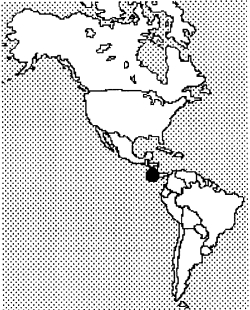Humiliation at Caverna Corredores
John Middleton
Caverna Corredores is a highly sporting river cave situated in the impressive 300m deep Corredores Gorge some 4km north of the Costa Rican town of Ciudad Neily. The gorge is clothed in dense primary rain forest and is home to an abundant fauna including monkeys, Jaguars, snakes, and parrots. The cave has a surveyed length of 1700m and this together with the surrounding karst was investigated by the Americans in 1989 and Canadians in 1990. Our visit in 1995 (my son and me) coincided with the wet season making the forest, river, and cave doubly challenging. The tortuous route up the gorge requires prior knowledge and for this we were assisted by the 19 year old daughter of the owner of the small hotel were we stayed. Maybe the trip would be easier than we thought…..
The derelict dirt road turned left and bumped steeply uphill into the early morning mist. We changed direction onto an indefinite track between the long grass. We stopped abruptly. An extremely long but beautifully marked snake silently slithered across our path. “Mucho peligroso” (very dangerous) exclaimed Leticia with a big grin. We continued into the forest, dismissing any other ideas we might have had about dusky senoritas and long grass, determinedly looking down and treading faithfully in her exact footsteps. We negotiated fallen trees, swamps, plants with vicious thorns and others with disabling stings. Then came the river. A 20m wide torrent of foaming white water. Leticia and her friend Christina waded straight in and with much laughter arrived soaked but safely on the bank directly opposite us. We stumbled, slipped, slithered, and arrived half drowned many metres downstream Five more life threatening crossings had to be undertaken before we landed on a small beach opposite the cave. Behind us was Caverna Alma, notable mainly for its small population of Vampire bats, whilst 50m upstream and on the other side, the powerful Rio Guaymi burst forth from the cliff down a 5m waterfall. We made one final and reasonably dignified river crossing before again being humbled on the 6m climb to the entrance. Here our ham-fisted attempt created much entertainment whilst the girls lithely swarmed up the vertical mud and tree roots.
The diy entrance was big, maybe 12m wide and 6m high and led into a well decorated chamber with two ways on. To the right an impressively large passageway gradually gave way to an extensive bat roost and associated stinking guano covered floor. Massive pseudo scorpions, cave crickets, cockroaches, and other nightmarish creatures scuttled everywhere. Suicidal bats aimed themselves directly at us. We retreated calmly and in good order consoling ourselves with the fact that the survey said this passage didn’t go anywhere anyway! The other large formation filled gallery gradually made a slippery, meandering descent to the main river, the Rio Guaymi. This completely filled the floor of a 10m wide superbly eroded tunnel. Downstream led quickly to a sump whilst to the right was over 500m of magnificent challenging streamway. At its end the passage continued dry but in a much smaller way whilst the river emerged sump like from the right hand wall. Out to impress, we swam straight in negotiating two small ducks within the first 30m before the passage again enlarged and our feet touched the bottom. We looked back and were amazed and very impressed to find Leticia and Christina directly behind us – they had never swum in a cave before let alone negotiate two ducks! More grand gallery followed and then the inevitable sump but just a few metres back a crawl invited inspection. We looked at it intently, the girls rushed straight in. “Arana” (spider), Christina excitedly shouted from up front. We raced forward just in time to hear a loud “splat” and arrive to see several 10cm long legs and a squashed body beneath her fist! The crawl then progressed into a rift and looped back to join the dry section of the main passage. A highly satisfying and incident free return was then made to the entrance.
With not an undue degree of apprehension we followed our leaders down to the river wondering what our downstream techniques might be. They proved remarkably simple, just throw yourself in a deep bit, get swept away, and grab the first sizeable boulder to slow progress! Bruised and battered and with a massive overdose of adrenalin coursing through us we eventually made it back and stumbled high spiritedly into Neilys nearest bar.
Some cave, some gorge, some river, some day, and most of all some girls! We definitely couldn’t have made it without them or am I just getting old?
In Costa Rica, limestone and karstic features have also been recorded on the Santa Elena Peninsular (reasonable cockpit karst), around Venado (Caverna Vernado 1km plus), on the Nicoya peninsular (mainly shafts into formation filled chambers – Santa Anna -240m), on the eastern side of the Gulf of Mcoya, inland from Quepos, and around Puerto Limon. We also visited the first three mentioned areas and enjoyed many more adventures amongst very friendly people. Potential for new discoveries is obviously considerable but none are likely to be of any great lengths or depth. There is a small active caving organisation in the capital, San Jose.
